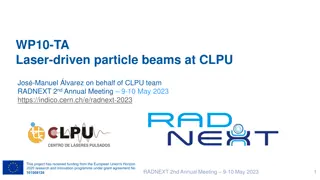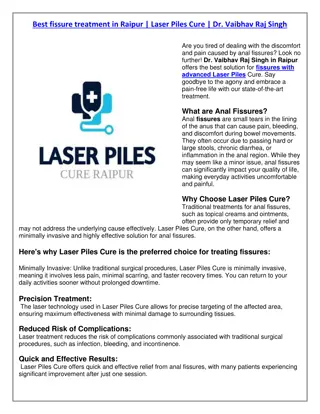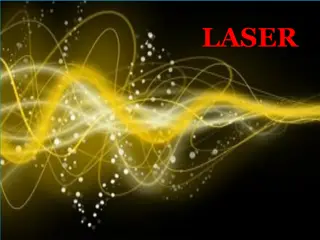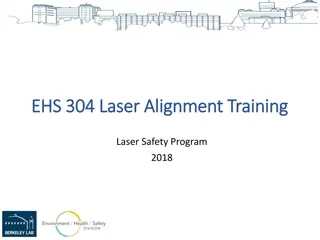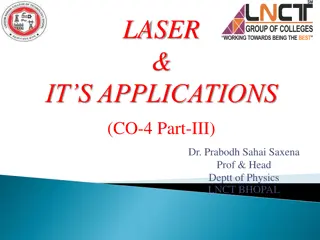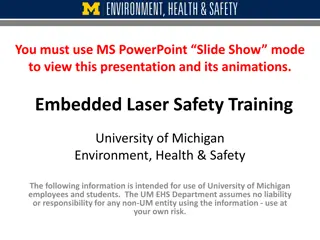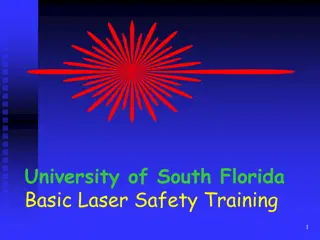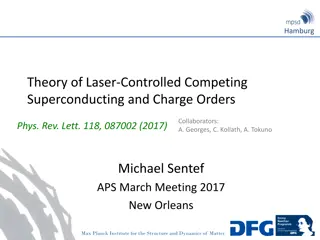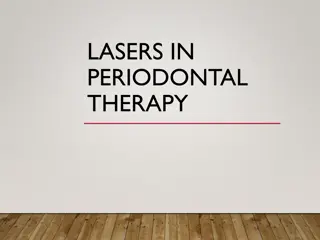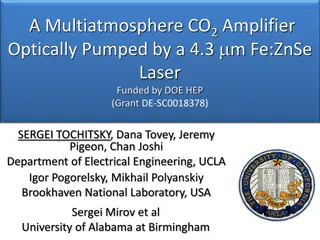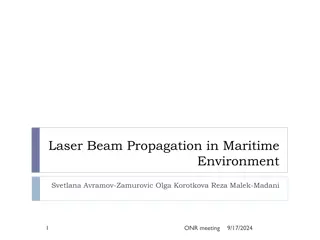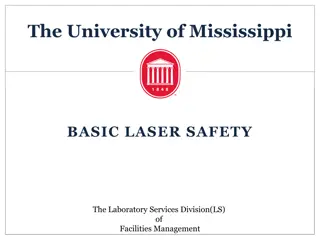Laser Safety Training: Understanding the Fundamentals
Explore the world of lasers and their components, from the active medium to the feedback mechanism. Understand the unique characteristics of laser light and the importance of laser safety training to prevent potential hazards.
Download Presentation

Please find below an Image/Link to download the presentation.
The content on the website is provided AS IS for your information and personal use only. It may not be sold, licensed, or shared on other websites without obtaining consent from the author.If you encounter any issues during the download, it is possible that the publisher has removed the file from their server.
You are allowed to download the files provided on this website for personal or commercial use, subject to the condition that they are used lawfully. All files are the property of their respective owners.
The content on the website is provided AS IS for your information and personal use only. It may not be sold, licensed, or shared on other websites without obtaining consent from the author.
E N D
Presentation Transcript
Online Self Study - Laser Safety Training
Introduction The term "LASER" is an acronym for: Light Amplification by Stimulated Emission of Radiation The laser is a device that emits a collimated (pencil-like) beam of either visible or invisible electromagnetic radiation (light).
Laser Components All Lasers are comprised of these essential elements: Active medium Excitation High reflectance mirror and the partially transmissive mirror (output coupler)
Laser Components The active medium can be any substance that, when stimulated, emits or "gives off" light energy and are made from gaseous, liquid, or crystalline solid substances. Often lasers are named for the specific element or substance, such as the helium, neon or ruby, which emits the light. The excitation mechanism in a laser causes electrons in the active medium to jump to higher energy levels. When the electrons drop back to a lower level energy, the energy difference between the two levels is released in the form of light, which is emitted from the medium. Light passing through the medium stimulates this emission in such a way as to amplify the light.
Laser Components It takes more than an active medium and an excitation mechanism to produce laser light. Such a system could produce light, but it would be emitted in all directions and would behave like ordinary monochromatic light. In order to produce a laser beam, a feedback mechanism is needed to amplify and to direct the output energy. The feedback mechanism consists of two mirrors placed at opposite ends of the active medium.
Laser Components The mirrors reflect laser light back and forth through the medium. On each pass through the medium, the intensity of the laser light is amplified. One mirror reflects essentially 100 percent of the light hitting it, while the other mirror, called partially transmissive mirror (output coupler) reflects only part of the light, transmitting the remainder. In this way some of the laser light is emitted from the laser. Sometimes the output coupler is blocked from the inside by a special material that can be "switched" from a transparent state to an opaque state. This special material enables the laser to be turned on and off so that it can produce pulses instead of continuous output.
Characteristics of Lasers Laser light has three unique characteristics, that make it different than "ordinary" light. It is: Monochromatic Directional Coherent Monochromatic means that it consists of one single color or wavelength. Even through some lasers can generate more than one wavelength, the light is extremely pure and consists of a very narrow spectral range. Directional means that the beam is well collimated (very parallel) and travels over long distances with very little spread. Coherent means that all the individual waves of light are moving precisely together through time and space, i.e. they are in phase.
Types of Lasers There are many types of lasers available for research, medical, industrial and commercial uses. The major types of lasers are: Gas Pumped solid state Dye Diode Gas lasers use a gas as the active medium. Common gas lasers are HeNe, CO2, N2, ion, and excimer. Solid state lasers, such as Nd:YAG, Nd:glass, and ruby, use crystal doped with heavy multi-electron atoms as the active media. Tunable dye lasers use a dye in a liquid active medium. Diode lasers use semiconductor materials as the active media.
Electromagnetic Spectrum Regions of the optical radiation spectrum
Electromagnetic Spectrum Region Ultraviolet UV-C UV-B UV-A Visible (Light) Near Infrared Far Infrared Wavelength (UV) 100 to 400 nm 100 to 280 nm 280 to 320 nm 320 to 400 nm 400 to 700 nm 700 to 1400 nm 1400 nmto 1 mm
Laser Classifications Lasers and laser systems are assigned one of the four broad classes (1 to 4) depending on the potential for causing potential damage. Class 1: "safe" if not disassembled. Example: Laser printers, CD-Rom players/drives Class 2: may exceed class 1 exposure limits if viewed more than 0.25 seconds [aversion respond time], but still not pose a significant eye hazards. Example: Supermarket scanners Class 3a: eye hazard if viewed using collecting optics, e.g., telescopes, microscopes, or binoculars. Class 3b: eye hazards if beams are viewed directly or specular reflections are viewed. Example: research Class 4: eye hazards if beams are viewed directly or specular reflections and sometimes even from diffuse reflections are viewed. Also skin burns from direct beam exposure. Example: research, manufacturing.
Viewing Laser Radiation Figures 1, 2, and 3 illustrate the different ways laser radiation can be viewed and therefore the different types of exposures an individual may encounter. Figure 1. Intrabeam viewing of direct (primary) beam. This type of viewing is most hazardous. Note that the diagram also illustrates that a laser beam may diverge as it propagates. Figure 2. Intrabeam viewing of a specularly reflected (secondary) beam from a flat surface reflector. Figure 3. Diffuse viewing of a diffusely reflected (secondary) beam from a rough surface in which a collimated beam is reflected in all directions.
Laser Exposure Limits Maximum Permissible Exposure(MPE) is defined as the level of laser radiation to which a person may be exposed without hazardous effect or adverse biological changes in the eye or skin. The MPE of a specific laser is determined based on the wavelength and exposure duration. Nominal Hazard Zone(NHZ) is the space within which level of the direct, reflected, or scattered radiation during normal operation exceeds the applicable MPE. Exposure levels beyond the boundary of the NHZ are below the appropriate MPE level.
The Structure of the Eye The eye is a complex optical instrument consisting of several parts. The CORNEA is exposed to the outside environment and therefore must repair itself rapidly because it is constantly faced with abrasion. It is transparent to all visible and near infrared wavelengths. The pupil is the opening that allows light into the eye. Its size is controlled by the light sensitive iris. The LENS is transparent to visible and near infrared light. Together with the cornea, the lens focuses light to the back of the eye. The shape of the lens changes to accommodate near or distant viewing.
The Structure of the Eye The RETINA is the layer of nerve cells that receives the image and sends signals to the brain. The FOVEA is the most sensitive area of the retina because it has the greatest concentration of cones. Rods and cones are the photoreceptors. The nerves leading from the rods and cones exit at the back of the eye through the OPTIC NERVE. The pigment epithelium is a layer at the back of the retina that absorbs light. The heat generated by the absorption of even environmental light in the pigment epithelium is removed by the blood flow in the choroid located just behind the retina.
Eye Hazards The site of damage depends on the wavelength of the incident or reflected laser beam as shown below:
Eye Hazards Visible (400 -700 nm) and Near-Infrared wavelengths (700 -1400 nm) are focused by the cornea and lens and are absorbed by the retina. This may result in a fovea burn which may be considered one of the more serious types of laser injuries. Mid-Infrared and Far-Infrared (1400 nm -1mm) wavelengths and Mid- Ultraviolet (180 -315 nm) are absorbed by water on the surface of the eye. Near-Ultraviolet (315 -390 nm) wavelengths are absorbed in the cornea and lens structures.
Skin Hazards UV-C (200 -280 nm): erythema (sunburn), skin cancer UV-B (280 -315 nm): accelerated skin aging, increased pigmentation UV-A (315 -400 nm): pigment darkening, photosensitive reactions Visible (400 -780 nm): photosensitive reactions, skin burn Infrared (900 nm -1 mm): skin burn
Non Beam Hazards -Electrical Lasers may contain high voltage power supplies and large capacitors or capacitor banks that store large amounts of charge. In general, systems that permit access to components with large charges must be interlocked; however, during maintenance and alignment procedures such components often become exposed or accessible. The proper high voltage electrical safety precautions should be utilized in these situations.
Non Beam Hazards -Electrical As a reminder, the following electrical safety precautions should be followed to help prevent electrical injury when working around laser equipment: Use one hand when working around power supplies, capacitors or other electrical equipment. Avoid wearing metallic items. Never handle electrical equipment when hands are wet or when standing on wet ground. With high voltages, regard all floors as conductive and grounded for high voltages unless they are covered with well-maintained dry rubber matting of a type suitable for electrical work. Be familiar with the following rescue procedures for application to apparent victims of electrocution: Kill the circuit. Remove the victim with a non-conductor if he is still in contact with an energized circuit. Initiate Cardio Pulmonary Resuscitation and continue until relieved by a physician.
Non Beam Hazards -Chemical One of the major sources of chemical hazards from lasers is from the organic dyes used in dye lasers. Other chemical hazards include toxic gases from excimer lasers, coolant such as liquid nitrogen, and gases that are formed by the interaction of the laser light with target materials. Please refer to the UNC Laboratory Safety Manual and your Laboratory Safety Plan in controlling or reducing your risk of exposure to these chemicals
Non Beam Hazards -Fire Class 4 lasers represent a fire hazard. Depending on the construction material, beam enclosures, barriers and beam stops are potentially flammable if exposed to high beam irradiance (>10 W/cm2) or beam powers in excess of 0.5 W for more than a few seconds. To prevent fire hazard: Beam enclosures should be constructed of flammable resistant materials. Electrical circuitry shall be evaluated for the potential to cause fire.
Non Beam Hazards -Explosion High-pressure arc lamps, filament lamps, and capacitors may explode violently if they fail during operation. Laser targets and some optical components also may shatter if heat can not be dissipated quickly enough. Care must be used to provide adequate mechanical shielding when exposing brittle materials to high intensity lasers.
Control Measures -Engineering Engineering controls are design features or devices that are applied to a laser or its environment for the purpose of reducing laser hazards. Engineering controls are considered to be the most effective types of control: Protective housing Interlocks Key control Beam stop or attenuator Activation warning systems: audible sound, warning light
Control Measures -Administrative Administrative controls consist of procedures and information provided to personnel for the purpose of reducing laser hazards. They are: Warning signs and labels Standard Operating Procedures (SOP) Training
Eye Protection Laser safety eyewear is required for class 3b and 4 lasers. The amount of attenuation is measured by optical density (OD). For instance, OD 5 means that the incident beam is attenuated by a factor of 100,000. The greater the OD, the greater the attenuation. Eyewear is very wavelength dependent. Safety eyewear for one type of laser will not work for another type of laser. Eyewear stamped OD 5 for 488 & 514 nm [Argon] may be OD 0 for 633 nm [HeNe]. All laser safety eyewear should be stamped with the OD at a particular wavelength.
Skin Protection Designation of protective clothing for UV lasers should be considered, even if not class 3b or 4. Fire resistant material should be considered when class 4 lasers are being used. Remote firing and monitoring should also be considered as a method of skin protection.
Common Causes of Laser Accidents According to ANSI(American National Standard) Z136.1-2000. Ninety five percentage of laser accidents occurs due to the following: Unanticipated eye exposure during alignment Misaligned optics and upwardly directed beams Available laser eye protection not used Equipment malfunction Improper methods of handling high voltage Intentional exposure of protected personnel Operators unfamiliar with laser equipment Lack of protection for ancillary hazards
Common Causes of Laser Accidents Common Causes (Continued): Improper restoration of equipment Eyewear worn not appropriate for laser in use Unanticipated eye/skin exposure during laser usage Inhalation of laser-generated air contaminants and/or viewing laser-generated plasma Ignition of fires of both a facility or personal nature Eye or skin injury or photochemical origin Failure to follow standard operating procedures (SOP)
Administrative Safety Practices Supervisors are responsible for training users on any laser-specific safety procedures for the laser they are operating. Standard Operating Procedures shall be developed for class 4 lasers. Only authorized personnel allow in vicinity of laser.
General Laser Safety Precautions Always consult with your laser manufacturer's guidelines for laser safety Always use proper laser eye protection Operate within a controlled area or secured enclosure only, unless the beam path is totally enclosed Keep the beam path well above or below the eye level Remove all unnecessary reflective surfaces from the area of the beam path Permit only properly trained & authorized personnel to operate the laser Enclose the entire beam path if possible Use the entire beam path if possible Use remote viewing methods where feasible (e.g. video monitoring) to accomplish any necessary view of the beam
Questions, Comments, Concerns Michael Bullard Environmental, Health, and Safety Officer O: 910.521.6792 Charles Chavis Environmental, Health, and Safety Professional O: 910.775.4772 C: 910.316.6356 Email: safety@uncp.edu C: 910.620.9553
Post-Test Congratulations! You have reached the end of the laser safety tutorial. If you have any questions, please contact the Laser Safety Officer at 910-521-6792. We would like to assess your training and also to document your participation in this self-study. To do this we have provided a short multiple choice test, please proceed to the online quiz at the following link: Online Laser Safety Quiz







